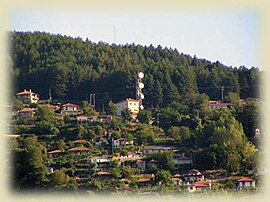This is an old revision of this page, as edited by Markussep (talk | contribs) at 20:41, 20 November 2011 (periphery --> region using AWB). The present address (URL) is a permanent link to this revision, which may differ significantly from the current revision.
Revision as of 20:41, 20 November 2011 by Markussep (talk | contribs) (periphery --> region using AWB)(diff) ← Previous revision | Latest revision (diff) | Newer revision → (diff) For other uses, see Granitsa (disambiguation). Settlement in Greece| Granitsa Γρανίτσα | |
|---|---|
| Settlement | |
 | |
| Country | Greece |
| Administrative region | Central Greece |
| Regional unit | Evrytania |
| Municipality | Agrafa |
| Municipal unit | Aperantia |
| Population | |
| • Community | 808 |
| Time zone | UTC+2 (EET) |
| • Summer (DST) | UTC+3 (EEST) |
| Vehicle registration | ΚΗ |
Granitsa (Template:Lang-el) is a mountain village in the Evrytania prefecture located at 850 meters of altitude. It is built into the forested downhill regions of Mount Liakoura next to the Granitsiotis River. It also offers views of the Granitsiotis valley and the mountain. Granitsa was the seat of the municipality of Aperantia. The village preserves its old appearance and it is 82 kilometers northwest from Karpenisi. It is the birthplace of artists such as Stefanos Granitsas, Demosthenis Goulas, and Michael Stafylas. It is also the home of Michael Mavroudis, who became a martyr after he was killed in 1544. Granitsa had seventeen churches, most of which were destroyed during Ottoman rule. It is worth visiting the Folklore Museum which contains popular art such as woven objects, carved wooden objects, rural cattle-raising tools, a loom, local clothes and weapons from the Greek Revolution of 1821. The museum also contains portraits and personal belongings of individuals such as Zacharias Papantoniou and Stefanos Granitsas, paintings of the popular local painters Christos Kagaras and Lefteris Theodorou and the personal book collection of Zacharias Papantoniou. Other notable sights are the remaining nine churches of the village. They were built in different time periods.
Subdivisions
Information
The main local products are fruits including watermelon, melon, figs and vegetables such as corn, tomatoes, potatoes, onions and cucumbers as well as dairy, livestock, olives and others. The majority of the population work in businesses as well as agriculture.
Houses were stone-built until the 1950s and did not surpass modern-style homes until the 1980s. They were linked with pavement in the 1980s. Most of the homes are abandoned today.
After World War II and the Greek Civil War, much of the population left for larger towns and cities. The population declined between the 1981 and the 1991 census but nearly doubled between the 1991 and the 2001 censuses.
Population
| Year | Village population | Municipal district population |
|---|---|---|
| 1981 | 601 | - |
| 1991 | 360 | - |
| 2001 | 474 | 808 |
Gallery
See also
External links
References
- De Facto Population of Greece Population and Housing Census of March 18th, 2001 (PDF 39 MB). National Statistical Service of Greece. 2003.
| Subdivisions of the municipality of Agrafa | |
|---|---|
| Municipal unit of Agrafa |
|
| Municipal unit of Aperantia |
|
| Municipal unit of Aspropotamos |
|
| Municipal unit of Fragkista |
|
| Municipal unit of Viniani |
|
